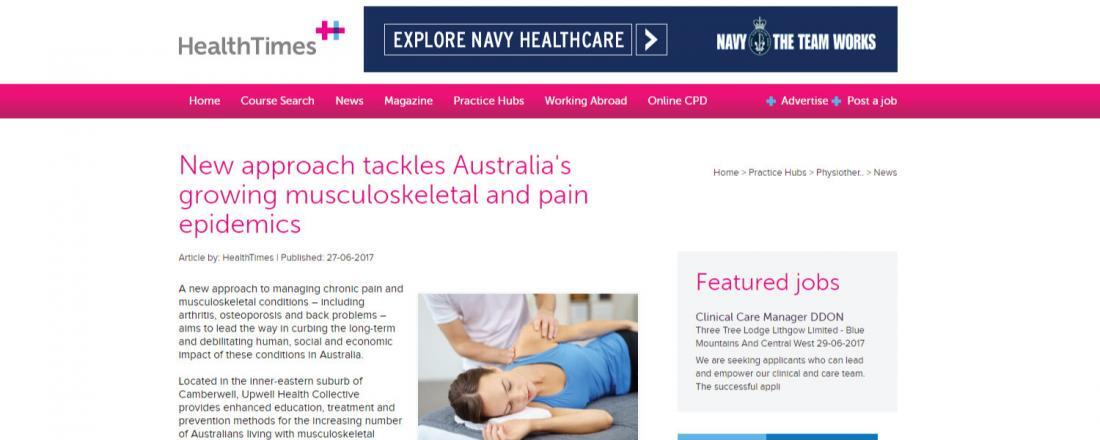
HealthTimes: New approach tackles Australia’s growing musculoskeletal and pain epidemics
Located in the inner-eastern suburb of Camberwell, Upwell Health Collective provides enhanced education, treatment and prevention methods for the increasing number of Australians living with musculoskeletal conditions and injuries and associated pain.
Meanwhile, as our nation’s third most costly health problem, chronic pain is estimated to cost our economy $34bn, with one in five Australians suffering from the condition in their lifetime. Upwell Health Collective blends a fully-integrated and collaborative patient care model with the latest healthcare technology and modern architecture designed to uplift.
Patients have access to a range of best-in-field musculoskeletal health professionals, including physiotherapists, podiatrists, occupational therapists and specialist clinical pilates trained physiotherapists – all at one accessible location. Evidence-based treatment drives patient care, with its team of over 30 staff adept in the latest industry research.
Clinical care is supported by wellness programs including personal and functional training, pilates, yoga, massage, meditation and acupuncture. These support patient mental and social wellbeing and help prevent relapse or re-aggravation of conditions or injury.
The centre includes co-working spaces where team members from across multiple disciplines come together to develop integrated and individualised treatment plans that aim to rehabilitate patients as quickly and efficiently as possible.
With prevalence rates of these conditions higher in older Australians, the centre also incorporates a Healthy Ageing program comprising on-site group exercise and health consultations and the provision of a range of in-home services.
“We offer a comprehensive and holistic approach to treating and managing our patients to give them the best chance of achieving full rehabilitation and living the best possible life – ultimately helping to reduce the burden of these conditions on our community,” says the centre’s Founder Matt Stanlake, a practising physiotherapist.
My experience both as a patient suffering from severe musculoskeletal injuries and chronic pain – and as a practitioner – has been that recovery can be severely impaired when patients are forced to seek input from multiple health specialists, at different locations.
I found that our fragmented medical services industry and the lack of communication and – in some instances – competitive tension between disciplines, greatly impacted the management of my own conditions and left me feeling confused about how to improve my health.”
Stanlake says providing access to more integrated healthcare services like Upwell is Australia’s best chance of tackling the interrelated epidemics of musculoskeletal conditions and associated chronic pain, mainly occurring as a result of our ageing population and sedentary lifestyles.
“My vision for healthcare in Australia is for a complete shift from the current model of fragmented, small-scale, cottage-based practices to a fully-integrated model such as the one we offer.”
The centre also addresses many issues that have been identified by the Australian Physiotherapy Association in their report released in 2013, which outlines critical strategic changes required for practices to remain competitive in the future. Some of these included offering a broader range of services, being more consumer-focused and more connected to technology.
Staff and patients at Upwell have access to the latest healthcare technology including a NASA-designed anti-gravity treadmill, virtual reality headsets for pain management, 3D modelling for patient education and a mobile device-based rehabilitation application that enables patients and their treating specialists to share information.
Recognising the importance of uplifting patient environments, the centre’s interior was designed by the creative minds behind the Australian headquarters of Google, Facebook, Twitter and Uber.
“Our industry has for too long delivered clinical care in drab and uninspiring facilities,” says Stanlake. “Instead we use beautiful design to support the treatment and recovery process.”
